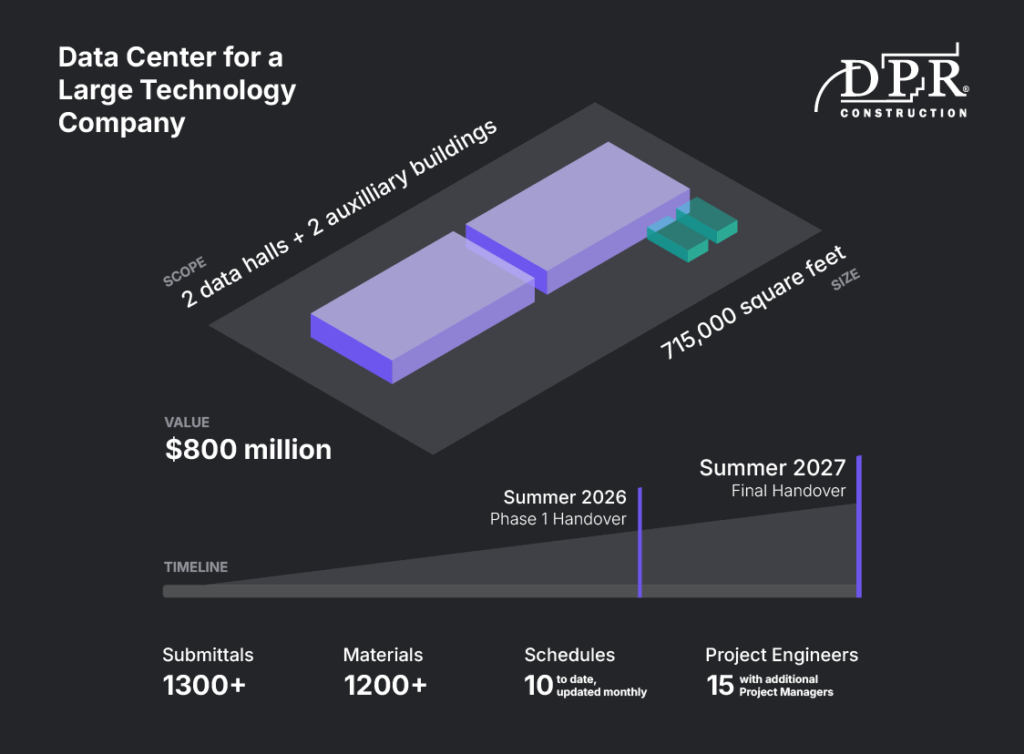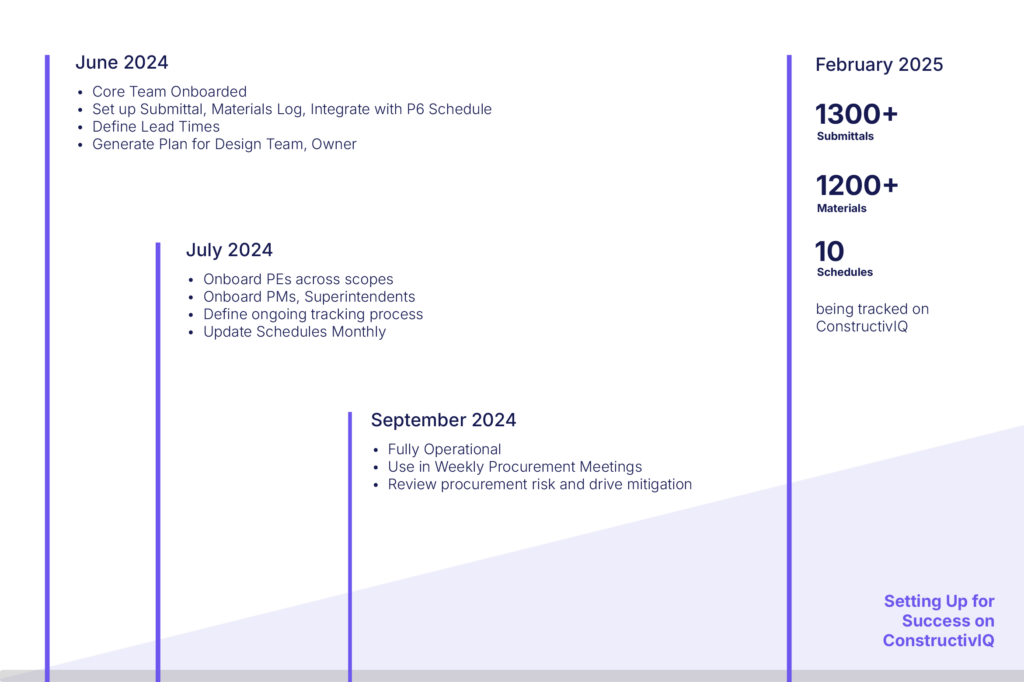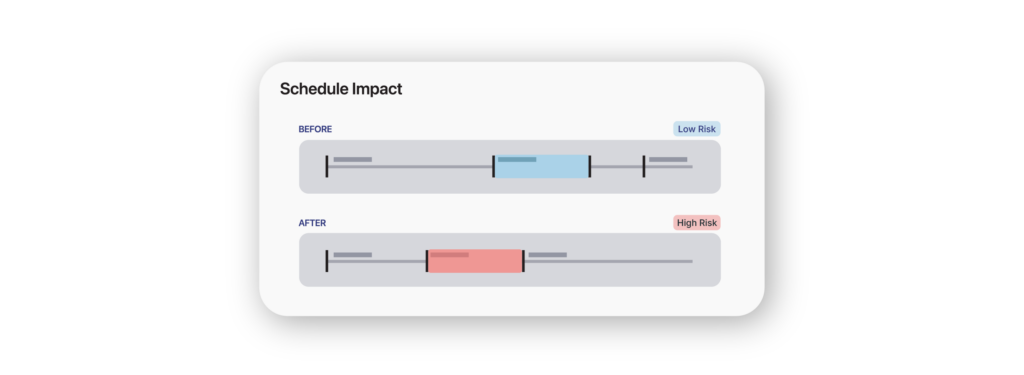Project Overview:
As demand for cloud computing and AI workloads continues to surge, data center construction has become one of the most rapidly growing sectors globally. Hyperscalers- large tech companies- are driving a significant portion of this investment, with the U.S. at the forefront of this expansion. DPR Construction is a leader in building data centers across the U.S., consistently ranked in the top 5 builders over the last 10 years in this market.

Procurement Challenge
A key challenge for DPR on these large-scale projects is managing the material supply chain, particularly when lead times for essential materials and equipment—such as switchgears, fiber optic cables, generators, chillers, and HVAC systems—are long and unpredictable. Relying on traditional tools such as Excel to manage these complexities in procurement results in ineffective planning and an increased risk of schedule delays.
Jackson Stricker, a project manager at DPR, emphasized, “The old wisdom on managing procurement just no longer applies.” The success of a project of this size is contingent on effectively managing procurement with a specialized, purpose-built system that can:
- Align procurement timelines with the overall project schedule (in Oracle P6).
- Automate updates for submittals (from Autodesk Construction Cloud) and schedule changes.
- Offer real-time tracking and risk mitigation capabilities.
To address these needs, DPR turned to ConstructivIQ for procurement planning and material tracking.
Solution
Implementing ConstructivIQ

Creating a Realistic Procurement Plan:
In the early stages of the project, the team was required to submit a detailed procurement plan with multiple due dates, including submittal reviews, approvals, and material fabrication and delivery. The team leveraged ConstructivIQ to create an integrated submittal and material log, linking all procurement activities to the project schedule. This ensured that the plan reflected accurate lead times and clearly showed workflow dependencies by working backward from the construction timeline.
Caroline Shoemaker, a Project Engineer at DPR, noted, “We were able to pull together a realistic procurement plan using this system, connecting the schedule to materials and submittals with all the required dates. The design team said it was the best plan they had seen.” By providing a clear plan and well-defined timelines, the team enhanced coordination between the design team and the project team.
“We were able to pull together a realistic procurement plan using this system, connecting the schedule to materials and submittals with all the required dates. The design team said it was the best plan they had seen.”
– Caroline Shoemaker
Onboarding and Operationalizing Procurement Tracking:
As the project ramped up, with a procurement plan in place, responsibility for tracking submittals and materials was distributed across the larger project team by scopes. To ensure smooth adoption, work sessions were held to familiarize the team with the platform. The team defined standardized processes for managing materials and submittals, achieving the following:
- For Project Engineers:
- Real-time tracking of materials and submittals, keeping them informed about upcoming tasks and deadlines.
- Increased transparency, allowing early identification of potential issues and enabling proactive corrective action.
- For Project Managers:
- Enhanced reporting capabilities for easier identification of high-risk areas.
- More efficient weekly procurement meetings, driven by up-to-date data, leading to informed decision-making.
Jackson Stricker observed, “Whether dates and estimates move up or down, we always have the latest updates, and we sleep better at night knowing that our ROJ (required on job) dates are truly accurate.”
“Whether dates and estimates move up or down, we always have the latest updates, and we sleep better at night knowing that our ROJ (required on job) dates are truly accurate.”
– Jackson Stricker
Understanding Changes and Mitigating Risk:
In a project of this scale, schedules are constantly evolving, making it essential to assess how changes impact procurement. With ConstructivIQ, the team could upload new schedule versions and run comparisons between different versions, allowing them to quickly identify changes and adjust priorities to prevent delays.
For example, when the schedule for the administrative building was re-sequenced, multiple tasks moved around in turn impacting procurement timelines. “Using ConstructivIQ, we were able to proactively mitigate risk by figuring out certain pipes had to be delivered earlier,” explained Jackson Stricker.

Continuous Improvement and Future Developments:
As the project progresses, in the spirit of DPR’s “Ever Forward” core value, the team continues to optimize procurement planning and tracking with ConstructivIQ. They are expanding the use of the system to involve more trade partners in managing and tracking materials, to implement dashboards to highlight critical actions, and to leverage advanced schedule information for procurement planning. “It’s been a very collaborative partnership. We appreciate how our feedback and feature requests have been quickly turned into capabilities that keep us productive,” said Robert Tolle, Integration Manager with DPR.
The team is also collaborating with ConstructivIQ to explore AI-driven insights to further enhance procurement efficiency, help predict delays and optimize workflows based on real-time data.

© ConstructivIQ Inc. This case study is provided for informational purposes only and is confidential. It may not be reproduced, distributed, or disclosed without prior written consent.